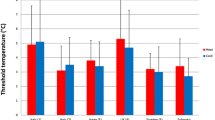Abstract
Working in the cold is part of the normal routine in outdoor occupations in winter in the subarctic regions, but there are few data available on occupational exposure to cold during outdoor work. In the present study, thermal responses were measured in winter in Finland during 23 working days among young, healthy men working in heavy, moderate and light daily outdoor jobs. During the measurements ambient temperature ranged from + 3 to − 27°C, air velocity from 0.2 to 4.3 m · s−1, and the subjects wore normal winter clothing. The skin temperatures measured often indicated disturbed performance, discomfort and a risk of adverse health effects, especially during the very cold days (ambient temperature less than − 15°C) in the light work. The most common problems were cooling of the extremities and the face and cool or cold sensations. The temperatures on the distal parts of the upper extremities correlated significantly with the heaviness of the work (r = 0.51, P = 0.014). The core temperature remained at the safety level in each case. Apart from clothing, an appropriate work load proved to be an effective way of keeping up the temperature of the extremities in cold work, and that should be taken into account when outdoor work is being planned.
Similar content being viewed by others
References
Anderson TW, LeRiche WH (1970) Cold weather and myocardial infarction. Lancet 1 (641):291–296
Anttonen H, Virokannas H (1994) Assessment of cold stress in outdoor work. Arctic Med Res 54:40–48
Anttonen H, Niskanen J, Rautiainen A, Rintamäki H (1993) Prevention of adverse effects of cold on food processing workers by infrared heaters. In: Nielsen R, Jörgensen K (eds) Advances in industrial ergonomics and safety Taylor and Francis, London, pp 369–376
Bergh U (1980) Human power at subnormal body temperatures. Acta Physiol Scand 478[Suppl]:1–39
Berglund LG (1979) Thermal acceptability. ASHRAE Trans 85:825–834
Budd GM, Hicks KE, Lugg DJ, Murray LG, Wigg DR (1969) Thermal discomfort in the antarctic and subantarctic. Med J Aust 2:1285–1288
Burton AC, Edholm OG (1969) Man on a cold environment. Hafner, New York, p 273
Clark RE, Cohen A (1960) Manual performance as a function of rate of change in hand skin temperature. J Appl Physiol 15:496–498
Durnin JN, Womersley J (1974) Body fat assessed from body density and its estimation from skinfold thickness. Br J Nutr 32:77–97
Elnäs S, Holmér I, Olesen BW (1984) Arbetsplatsens termiska klimat, mätning och bedömning (Thermal conditions, measurement and assessment in workplaces). Work environment program of the nordic council of ministers. Stockholm, p 123
Enander A (1984) Performance and sensory aspects of work in cold environments: a review. Ergonomics 27:365–378
Forsthoff A (1982) Arbeit in — 28°C. Arbeitsphysiologische Untersuchungen zur klimatischen Belastung bei Körperarbeit tiefen Umgebungstemperaturen unter besonderer Berucksichtigung der Kühlhausarbeit. Dokumentation Arbeitswissenschaft. Ein Leser-Service der Zeitschrift für Arbeitswissenschaft, Ascheberg, Westfalen
Gavhed D, Nielsen R, Holmér I (1991) Thermal responses to cold exposure-intermittent work. In: Queinnec Y, Daniellou F (eds) Design for everyone, vol 2. Proceedings of the 11th Congress of the International Ergonomics Association, Paris 1991. Taylor and Francis, London, pp 935–937
Hellström B, Berg K, Vogt LF (1970) Human peripheral rewarming during exercise in the cold. J Appl Physiol 29:191–199
Hessemer V, Langusch D, Bruck K, Bödeker RH, Breidenbach T (1984) Effect of slightly lowered body temperatures on endurance performance in humans. J Appl Physiol 57:1731–1737
Holmér I (1984) Required clothing insulation (IREQ) as an analytical index of cold stress. ASHRAE Trans 90:1116–1128
Holmér I (1991) Assessment of cold stress. Arctic Med Res 50 [Suppl 6]:83–88
Horvath S (1981) Exercise in a cold environment. Exerc Sport Sci Rev 9:221–263
International Standard Organisation (1992) Evaluation of cold environments. Determination of required clothing insulation, IREQ. Technical report ISO/TR-11079. ISO, Geneva
Ilmarinen R (1985) Hand grip strength decrease related to hand skin temperature drop during six-hour ice cold water immersion. Safe J 15:16–20
Ilmarinen J, Knauth P, Klimmer F, Rutenfranz J (1979) The applicability of the Edholm scale for activity studies in industry. Ergonomics 22:369–376
Kaufman WC (1983) The hand and foot in the cold. Phys Sportsmed 11:156–158
Lange Andersen K, Shephard RJ, Denolin H, Varnauskas E, Masironi R (1971) Fundamentals of exercise testing. World Health Organisation (WHO), Geneva, p 133
Lotens WA (1988) Comparison of thermal predictive models for clothed humans. ASHRAE Trans 90:1321–1340
Mitchell D, Wyndham C (1969) Comparison of weighting formulas for calculating mean skin temperature. J Appl Physiol 26:616–622
Pivarnik JM, Grafner TR, Elkins ES (1988) Metabolic, thermoregulatory, and psychophysiological responses during arm and leg exercise. Med Sci Sports Exerc 20:1–5
Pugh LG (1967) Cold stress and muscular exercise, with special reference to accidental hypothermia. BMJ II:333–337
Rintamäki H, Hassi J, Oksa J, Mäkinen T (1992) Rewarming of feet by lower and upper body exercise. Eur J Appl Physiol 65:427–432
Savourey G, Vallerand AL, Bittel HM (1992) General and local cold adaptation after a ski journey in a severe arctic environment. Eur J Appl Physiol 64:99–105
Sawka M, Pimental N, Pandolf K (1984) Thermoregulatory responses to upper body exercise. Eur J Appl Physiol 52: 230–234
Siple PA, Passel CF (1945) Measurements of dry atmospheric cooling in subfreezing temperatures. Proc Am Phil 89:177–199
Suurnäkki T (1991) Stress and strain of elderly employees in municipal occupations. Scand J Work Environ Health 17:30–39
Tipton M, Golden F (1987) The influence of regional insulation on the initial responses to cold immersion. Aviat Space Environ Med 58:1192–1196
Virokannas H, Anttonen H (1993) Risk of frostbite in vibration-induced white finger cases. Arctic Med Res 52:69–72
Virokannas H, Anttonen H (1994) Body heat balance reflected by skin temperature on the hand in light and heavy work in cold condition. Arch Complex Environ Studies 5:91–95
Vuori I (1987) The heart and the cold. Ann Clin Res 19: 156–162
Ward M (1974) Frostbite. BMJ I (897):67–70
Author information
Authors and Affiliations
Rights and permissions
About this article
Cite this article
Virokannas, H. Thermal responses to light, moderate and heavy daily outdoor work in cold weather. Eur J Appl Physiol 72, 483–489 (1996). https://doi.org/10.1007/BF00242279
Accepted:
Issue Date:
DOI: https://doi.org/10.1007/BF00242279




